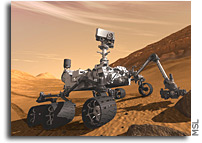Four Cornell space researchers named to instrument teams for NASA’s next Mars rover mission in 2009

ITHACA, N.Y. — Four Cornell University space scientists are on five
of the eight teams that will begin planning the science program for
NASA’s next Mars rover mission, the mobile Mars Science Laboratory
(MSL), scheduled for launch in 2009.
The space agency has chosen the eight proposals to provide
instrumentation and associated science investigations for the
mission, which is intended to explore a local region as a potential
habitat for past or present life.
Cornell professor of astronomy Steve Squyres is on the teams for two
of the experiments, the Sample Analysis at Mars (SAM) and the
Alpha-Particle-X-Ray-Spectrometer (APXS). Squyres currently is
principal investigator for the Mars Exploration Rover (MER) mission,
which has two rovers conducting scientific experiments on opposite
sides of the planet.
Jim Bell, associate professor of astronomy at Cornell, and senior
researchers Rob Sullivan and Peter Thomas are on teams for three
imaging experiments from Malin Space Science Systems, San Diego,
Calif. Bell currently is leading the panoramic camera, or Pancam,
team for the MER mission. Sullivan also is a member of that team,
which has its calibration and processing lab for the mission’s
panoramic images on the Ithaca campus. Thomas is a member of both the
Cassini Saturn obiter team and the science team for the forthcoming
Deep Impact mission that next year will collide a large projectile
with the comet Tempel 1.
The SAM is an integrated suite consisting of a gas chromatograph mass
spectrometer and a tunable laser spectrometer. The APXS would
determine elemental abundance of rocks and soil and will be provided
by the Canadian Space Agency.
One of the Malin proposals is a mast-mounted camera that would
perform multi-spectral, stereo imaging at lengths ranging from
kilometers to centimeters and would be able to acquire compressed
high-definition video at 10 frames per second without the use of the
rover computer. One of the camera’s co-investigators is movie-maker
James Cameron, director of “Titanic.”The other Malin instruments are
a “hand lens” imager for imaging rocks, soil, frost and ice at
resolutions 2.4 times better–and with a wider field of view–than
the microscopic imager carried by the current Mars rovers; and a Mars
descent imager that would produce high-resolution, color-video
imagery of the MSL descent and landing phase, providing geological
information as well as pinpointing the landing site.
The MSL mission is scheduled to arrive on Mars in 2010. The MSL
operates under its own power and would be expected to remain active
for two years (one Martian year). The mobile laboratory also would
carry a pulsed neutron source and detector for measuring hydrogen
(including water), a meteorological package and an ultraviolet sensor.
Malin Space Systems’ founder and president is Michael Malin, who has
a long history of collaboration with Cornell’s Department of
Astronomy. The company built and operates the Mars orbital camera
aboard the Global Surveyor spacecraft, which was launched in 1996 and
continues to orbit the planet. The company has built two cameras for
NASA’s 2005 Mars Reconnaissance Orbiter mission and the descent
imager for the 2007 Mars Scout Phoenix mission.
The MSL mission will be managed by NASA’s Jet Propulsion Laboratory,
Pasadena, Calif., for the NASA Science Mission Directorate,
Washington, D.C.
Related World Wide Web sites: The following sites provide
additional information on this news release. Some might not be part
of the Cornell University community, and Cornell has no control over
their content or availability.
o Malin Space Science Systems, Inc. press release describing
the cameras for the mission:
http://www.msss.com/press_releases/mslselection/index.html
o NASA: http://www.nasa.gov









